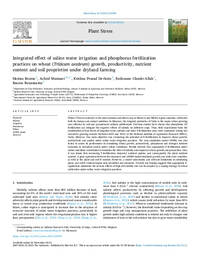Integrated effect of saline water irrigation and phosphorus fertilization practices on wheat (Triticum aestivum) growth, productivity, nutrient content and soil proprieties under dryland farming

Authors:
Wheat (Triticum aestivum) is the most common and oldest crop in Morocco and MENA region countries, cultivated both for human and animal nutrition. In Morocco, the irrigated perimeter of Tadla is the major wheat growing area affected by soil and groundwater salinity problematic. Previous studies have shown that phosphorus (P) fertilization can mitigate the negative effects of salinity on different crops. Thus, field experiments from the combination of four levels of irrigation water salinity and three P-fertilization rates were conducted during two successive growing seasons (between 2019 and 2021) at the National Institute of Agronomic Research (INRA), Tadla, Morocco. Our main objective was evaluating the potential of P-fertilization to improve wheat growth, productivity and quality under saline water irrigation practices. The crop simulation model APSIM, was also tested to assess its performance in simulating wheat growth, productivity, phosphorus and nitrogen nutrient dynamics in soil-plant system under saline conditions. Results showed that appropriate P-fertilization under saline conditions contributed to minimize the effect of salinity and improved wheat growth and production. Also, it was found that increasing P-fertilization improved nutrient uptake, and consequently the plant nutrient content. A good agreement between the measured and APSIM model simulated growth and yield state variables, as well as the plant and soil-N content. However, a model uncertainty and relevant limitations in simulating plant- and soil-P content output were identified and discussed. Overall, our finding suggests that appropriate P- application minimizes the adverse effects of high soil salinity and can be adopted as a coping strategy in wheat cultivation under saline water irrigation practices.
